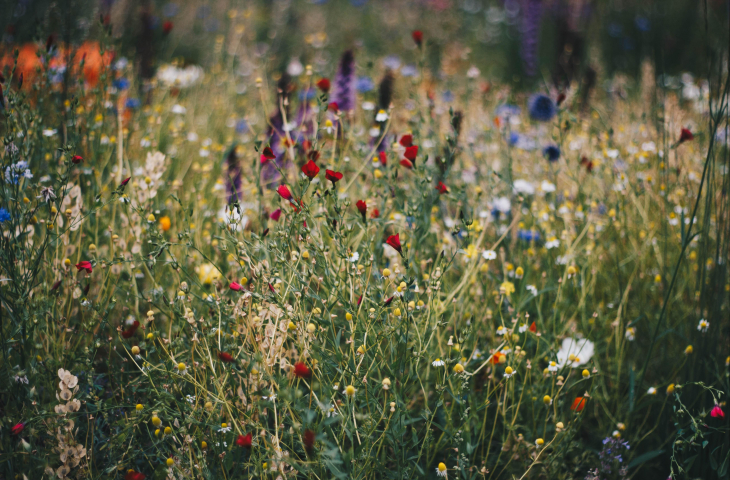Victor: Just when we're mowing, isn't that carbon dioxide equivalent released?
Joanna: Unless we are mowing with a combustion mower and burning the hay then no. If we give the hay to the animals to eat then they will build carbon into their tissues and excrete the rest. If we turn it into compost or use it for mulching, we don't have the problem even more, because we will put it directly into soil storage.
Victor: I have to admit that I never thought of flower meadows in this context.
Joanna: I myself have started analyzing the carbon cycle for some time, trying to understand the process. Plants are, first of all, a transmitter of carbon to soil storage in the form of humus, the content of which, after all, is measured by the amount of carbon in the soil. On the other hand, soils devoid of humus and plant cover, especially agricultural soils, are the very areas prone to wind erosion and additional carbon emissions. The dust storms we saw this spring are a painful example of this.
Victor It's also hard not to ask about the two crowning arguments of the proponents of harsh cuts.
Joanna: I'll say right away which ones - Ticks?
Wiktor: Yes, you guessed the first one and the second one?
Joanna: Probably allergists.
Wiktor: Excellent, that's what I wanted to ask.
Joanna: In the case of allergists, there are a growing number of research results available that focus on the causes and effects of allergies in the context of urban greenery and the effects of climate change. I have the impression that the common belief, about grassland as a source of serious discomfort for allergy sufferers is a matter of confusing cause and effect.
According to research, pollen allergies are not a cause of disease, but a result of air pollution and dryness which leads to allergies, asthma, but also other so-called "civilization" diseases, such as circulatory problems, heart disease and even obesity. In fact, the presence of multi-species and multi-storied greenery, including flower meadows, reduces the urban heat island effect by moderating the daily temperature amplitude, and also humidifies the air by binding airborne allergens, dust and other pollutants! Therefore, in fact, it is the lack of greenery in cities and the air that is dried out as a result, that is the direct cause of the increasing effects of allergies in cities, not plants and meadows that cause them[1].
An example of greenery designed by Rayss Group
© Rayss Group
In fact, ultimately we should fight for a greater share of greenery in cities to help allergy sufferers.
In addition, if we frequently mow the lawn, we expose allergic people to even more inconvenience, because these grasses and other plants of meadow communities that are mowed repeatedly try to continually close their life cycle. Thus, they bloom repeatedly, producing pollen, not infrequently and several times a year as a result of constant mowing. If we let them bloom once, the discomfort is once in a shorter period.
It is also worth remembering the need for desensitization. After all, some of us are allergic to cat dander, for example, and I have yet to hear demands that we consider eliminating cats from the city for this reason. Not to mention allergies to dust, because, after all, that's impossible....
Victor: Okay, but what about ticks?
Joanna: It's another myth that these ticks are just waiting for us just in a flowery meadow or forest. Numerous studies and those more scientific and those popularized (I highly recommend the fantastic and professional site: Pest Controllers(see here)). Ticks adapt to the functioning of their victims, and today we are more likely to encounter them in playgrounds or short-cut lawns than in the mythical hazel or tall flower meadow. In general, it's hard to meet them at heights above 150 centimeters, due to their structure and the way they "hunt." In addition, in a flower meadow, thanks to the fact that we do not exterminate other creatures, scaring and killing them while mowing, we favor biodiversity. Thanks to this, there are also creatures that naturally compete with ticks or eat them. In addition, let's remember that floral meadows are not spaces that we walk through freely...they should be located where they are used for viewing rather than tearing through them....
The problem of ticks in relation to flower meadows is exaggerated
© Pexels
Victor: Do you see as a practitioner a change in the public's attitude toward mowing? Have we changed attitudes in recent years? Which cities are changing their policies towards mowing?
Joanna: According to my observations, there is indeed a change in the intensity of mowing public areas, which is the result of education and popularization of good patterns. This is a practice that the Greenery Boards don't need to be particularly persuaded to do, because for them it is simply a cost-saving measure.
However, you don't see this trend in private gardens, unfortunately. In these spaces there is still a cult of "perfect-green" and mowed to a maximum of 1 centimeter of monoculture lawn. And the very fact that we use the word "ideal" in this juxtaposition is the worst...it is evidence of the archaic, modernist aesthetic pattern in which our society lives.
In addition, I think the blame should also be placed on the entire gardening industry living off this mowing, watering, fertilizing and "weeding" of lawns, with the fashion for "intelligent unmanned mowing robots" at the forefront. This is simply the result of the commercialization of such solutions - followed by the sale of corresponding technical solutions. And I must strike my breast here as a representative of the green industry. Unfortunately, many of my colleagues - designers - promote these non-environmental practices. I am convinced that the biggest problem is the lack of proper lobbying for meadows, because it is difficult to make money on them. That's why it's gratifying to have talks like this one today, because it's an actual promotion of ecological practices.
Victor: By the way, I would like to talk about green wastelands in the city. This is often a term for neglected and overgrown areas? There is a growing idea that some of these areas should not only not be developed, but even cleaned up? Should such urban jungles stay with us?
Joanna: Absolutely yes. The stepping stone to this is the question of naming - behind the name there is also evaluation and valuation. The very fact that we call something a wasteland has a pejorative character. If something is a landscaped green space, we immediately have a better opinion of it, because someone took care of it, and we expect action from the offices and units paid for by our taxes. "Wastelands," on the other hand, are "neglected." This is the problem with the acceptance of spontaneous greenery in urban areas. The direction to call these spaces fourth or fifth nature, succession park, natural park, etc. is primarily a way to change these pejorative terms.
It is the same with weeds, even if it is native vegetation, it is given such a pejorative character by its very name. And yet this spontaneous greenery also, and sometimes even primarily and in spite of everything, provides ecosystem services, and does so for free!
Victor: Thank you for the interview!
interviewed by Wiktor Bochenek
[1] Summary of research available in publications, among others: EASAC, PAN, (2019). https://instytucja.pan.pl/index.php/aktualnosci-wspolpraca-miedzy- national/5241-health-of-Europeans-depend-on-action-on-climate-change; Sellers S., Ebi K.L., (2018). Climate change and health under the shared socioeconomic pathway framework. International Journal of Environmental Research and Public Health. 15, 3.; Probl Hig Epidemiol 2009, 90(3): 316-321; Koenig J. Q., Covert D. S., 1989, Effects of Inhalation of Acidic Compounds on Pulmonary; Function in Allergic Adolescent Subjects. Environmental Health Perspectives, 79: 109-113. ].































